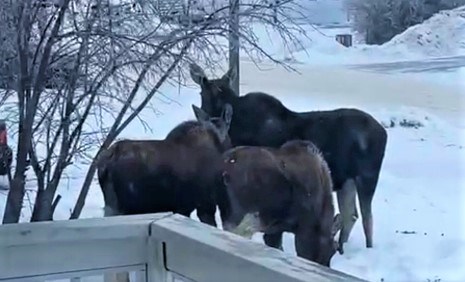MIDALE - Conservation officers were called to Midale on Jan. 17 to help relocate three moose – a cow and two calves – that ended up in Jennifer Biette's backyard and were seen elsewhere in the community.
Biette said she looked out her window at about 11:30 a.m. that day and saw them eating off of a tree. She noted the moose had been in the town for a while, and they found their way into her backyard.
Lindsay Leko, a conservation officer based out of Weyburn with the Ministry of Corrections, Policing and Public Safety, said moose come into Midale quite often as it's almost like a "gem in the middle of nowhere" for them, and these particular animals were also known to the community.
"The town of Midale, much like any other town or yard, offers some unique cover and protection for them. These moose had been in the town for quite a while," Leko said.
On Jan. 17, when conservation officers were called to the scene, they had to assess the situation, estimate how much risk a cow and two calves were posing, determine whether the wildlife could stay or needed to be moved and formulate a plan on how to deal with the animals. Leko said due to the location, as they were right in the core area of Midale, and also due to the fact that a cow would be protective of her calves, they decided to relocate the animals.
"Officers confirmed that the three moose were in fact bedded down in the backyard in Midale. So, we mobilized some equipment and some manpower and we came in with the plan to chemically immobilize them and relocate them to better habitat outside of the town of Midale," Leko said.
Officers sedated the cow first, and once it went down proceeded with the calves.
"Cows always go down in an area where it's not really great to have to recover them, but that's something we have to adapt to," Leko said. "The calves didn't go too far from the mom. We immobilized each of them as well with our drugs and delivery equipment, and the cow and one calf were put in the back of an enclosed trailer, and the other calf was put in the back of the truck with the assistance of the town maintenance staff. And all three were taken to a safe location away from Midale near the Rafferty land."
The animals were given reversal drugs. The two calves fully recovered from sedation, but the cow, unfortunately, did not.
"We feel it went into a mode of capture myopathy and despite several attempts, she was unable to recover. So, we had to humanely euthanize her," Leko said. "Basically, what capture myopathy is, it's muscle damage that domestic and wild animals receive as a result of chemical immobilization. And the damage is caused by the exertion, the struggle, the stress."
He added the calves seemed fine after recovery and were grown up enough to be able to make it on their own. The officers came back to check on them the next day, and they were gone.
"We're under the impression that they did move on and we think they're at the age now, probably where the mom would have been kicking them out in the next couple of months anyways, they weren't little tiny things, so they definitely were able to go off on their own," Leko said.
He noted situations like this happen, but not very often. Conservation officers weigh the circumstances and decide the best way to go.
"Officers come in and we make a determination. Many times, the relocation is successful. Sometimes it's not based on the condition of the animal, how much trouble we had in recovering the animal, how long we have to take them away to a safer place to relocate. So, it's not always a good news story. But in this one, we just couldn't keep them in the town of Midale anymore," Leko said, adding that the cow was already wound up in defence mode trying to protect her calves, which affected the situation.
Once an animal is immobilized, officers check their condition, perform first aid, treat any wounds and ensure they rest comfortably while being relocated. However, every situation is different, and sometimes wild animals can't recover.
He also pointed out that southeast Saskatchewan is a moose country, and they've been receiving many moose-related calls. Some people just inform them about an encounter, while in other cases animals were moved.
Leko noted that whenever people run into wildlife, there are a few basic things they should keep in mind. And with another cold spell here, there is a good chance more moose will be seeking shelter and protection from predators in the communities.
"Moose, along with many other species of wildlife, is a natural part of our landscape. Decades ago, maybe moose weren't that common, but now they are. And I think that they've become pretty accustomed to coexisting with us in different environments," Leko said.
"So, we have to make sure that we're educating our kids and everyone that moose are around and what to do if you happen to see one."
Keeping a safe distance is one of the main rules when encountering a moose. Moose are big wild animals, they may get defensive, and they move very fast even in deep snow, so "taking a selfie may not end up well," Leko said. He added that keeping dogs on a leash is also important, as sometimes if they run at large in smaller communities, they may start chasing wildlife, which would make the wildlife become protective and more dangerous.





